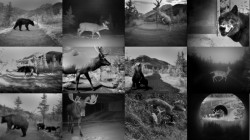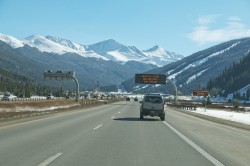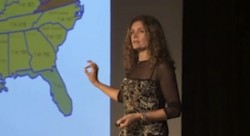New Thinking
Why are animals dying on our roads?


The prevalence of roadkill is both an obvious and unfortunate result of the conflict between the needs of humans and animals. The human need to get to where we are going safely and quickly is a basic expectation of modern society. Yet wild animals need to cross our roads in search of food, mates and shelter. Our expanding network of roads, highways and interchanges criss-crosses the continent, interrupting and fragmenting our landscapes—and with it, the territories of wild animals. Many are routinely struck and killed by vehicles in this most basic quest for survival.
Yes, this costly and tragic problem can be avoided using crossing structures. These are proven solutions that when designed and implemented strategically can radically reduce the number of collisions to save costs and, most significantly, human and animal lives.
This is where the work of ARC begins. ARC engages new thinking to design crossing structures that reconnect landscapes, safeguarding our wildlife populations, their habitats and our ecosystems.
The problems with roads
“Because accidents between animals and people are scattered, happening here, there and everywhere over time, it’s difficult to grasp the scope of roadkill, and understand that it’s a systemic problem.” —Jeremy Guth, trustee, Woodcock Foundation, and ARC founding sponsor
We have been busy building roads for more than half a century in North America. Today, there are more than 4.8 million miles (7.8 million km) of roads on the continent. Americans have the highest rate of private automobile ownership on the planet, with more than a quarter billion vehicles using these roads. Given the dominance of the road in North America, and the fact that we now spend on average about 1.5 hours per day in the car, it has become disturbingly commonplace—even acceptable—for wildlife to be killed on our roads.
But this is not merely a wilderness or rural issue—it is a problem that affects everyone; those of us living and driving in busy suburban and urbanizing landscapes are more likely to witness or experience the conflicts first-hand. In fact, growing numbers of wildlife-vehicle collisions are leading to higher levels of personal injury and property damage, and rising insurance premiums. While human deaths are not high compared with other accidents, wildlife-vehicle collisions have increased significantly. A U.S. Federal Highway Administration study reports that there are approximately one million to two million collisions between cars and large mammals every year in the U.S. This represents a significant danger to human safety and wildlife populations. Wildlife-vehicle collisions are also increasing as a proportion of the total accidents on the continent’s roads. Even if not physically hurt or economically affected by a collision, many people report feeling traumatized after hitting an animal.
Alongside these obvious concerns for motorist safety are serious implications for wildlife. Road mortality is documented as one of the major threats to the survival of 21 federally listed threatened or endangered species in North America. At a much larger scale, road building results in significant losses of habitat for wild animals. Road networks carve up and fragment our landscapes into small, isolated patches in which wildlife must live and move. Worse yet, wildlife movement patterns often conflict with major transportation routes. Most of North America’s major highways cross the continent in an east-west orientation, but wildlife movements tend to flow north-south following mountain topography, such as the Rockies, the Appalachians and the coastal ranges. These landforms have always been important habitat and migration corridors, and they are becoming even more essential. Research on climate change suggests many wildlife species may be forced to migrate in new patterns across our landscapes in search of new habitats as resources become scarce in their current home ranges.
The solution: avoid the problem
“At what point in our evolution as a society did it become okay to run over wildlife? We need not tolerate hitting a deer on the way home from a ski trip. It’s a circumstance that’s avoidable.” —Ted Zoli, bridge engineer and MacArthur Fellow
Roadkill is not simply “bad luck” or an unfortunate consequence of driving, but an avoidable cost and a preventable loss. We know there are solutions that work; what we need is political will and social awareness to implement proven solutions in the right places.
Today, an emerging priority for transportation and natural resource agencies is to make highways safer for both drivers and wildlife. One of the proven solutions is to build wildlife crossing structures. Providing crossing infrastructure at key points along transportation corridors is known to improve safety, reconnect habitats and restore wildlife movement. Throughout Europe, Asia, Australia and North American, wildlife crossing structures have been implemented with demonstrable success.
Crossing structures include underpasses and overpasses, both of which have been constructed in a variety of sizes and designs. Although wildlife underpasses are less costly to build and more commonly used by a diversity of species, wildlife overpasses are preferred by certain wide-roaming and iconic species-at-risk, such as grizzly bears. Overpass structures are also more visible and noteworthy to motorists.

“People need to move around and they use highways to do that. When people learn that wildlife have the same needs that they do, and that the animals are often moving across those very same highways, they understand there’s a problem to solve.” —Harvey Locke, conservationist and ARC partner
![ARC [diagram]](https://arc-solutions.org/wp-content/themes/arc/images/arc-diagram.jpg)




